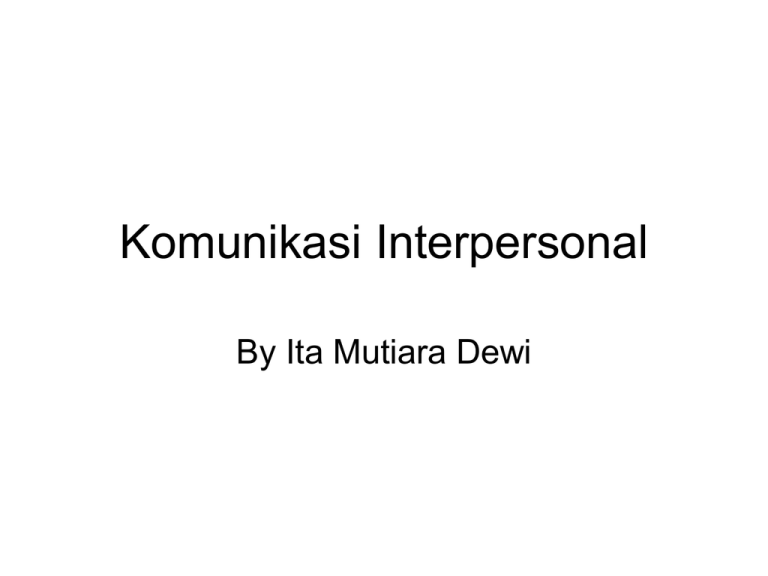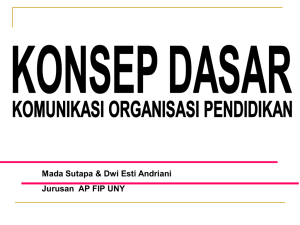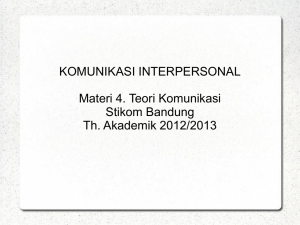Komunikasi Interpersonal By Ita Mutiara Dewi
advertisement

Komunikasi Interpersonal By Ita Mutiara Dewi Komunikasi antar Manusia (DeVito) • • • • • • • Intrapribadi Antar pribadi Kelompok kecil Organisasi Publik Antarbudaya Massa Ilustrasi komunikasi (Hartley) a) b) c) d) e) Diskusi sambil makan siang di kantin Pertengkaran antara ayah dan ibu berkaitan perilaku anaknya diskusi antara dosen dan salah satu mahasiswanya Telpon dari suatu perusahaan berkaitan informasi produk baru Surat dari anak ke orang tuanya berkaitan pengalaman kerjanya di luar negeri f) Penjual menawarkan dagangan obral di pasar g) Orasi orator di depan pengunjuk rasa h) Pidato kenegaraan presiden i) Tontonan film di bioskop j) Siaran berita di TV k) Berita di Surat kabar The nature of the audience • Items (f) to (k) all involve large audiences ranging from the crowd in the market (f) to potentially the whole society ((h) or (k)). Thus, the receivers of the communication are not known as individuals to the sender. In some cases the sender is an individual but in others the sender is a group or organisation, or an individual acting on behalf of an organisation (e.g. the newsreader in (j)). Relationship • Items (a) to (e), in contrast, all involve events where the participants are specific individuals who are known to one another. This knowledge of the other person is a very important aspect of the interaction. Medium or channel of communication • Items (a) to (c) are purely face to face whereas items (d), (e) and (g) to (k) all use some medium of communication in between the senders and receivers. • Item (f) may use some form of medium, e.g. a public address system, but this will depend on the size of audience and the strength of the trader’s lungs! Interpersonal? • Only examples (a), (b) and (c) in the above list are ‘pure’ examples of what • interpersonal communication has the following characteristics: • communication from one individual to another • communication which is face to face • both the form and content of the communication reflect the personal • characteristics of the individuals as well as their social roles and relationships Komunikasi Interpersonal Face-to-face meetings Interpersonal communication involves faceto-face meetings between two participants. Roles Interpersonal communication involves two people in varying roles and relationships to one another • formal positions such as policeman, teacher, etc., and the more informal roles which we may take on in some situations, e.g. the person who always intervenes to try to alleviate conflict in a group of friends – the ‘harmoniser’. Two way • Interpersonal communication is ALWAYS two way. • The so-called linear model of communication is one of the most popular ways of representing communication. This model suggests that our communication is linear and one way. In other words, it consists of messages which flow from sender to receiver along particular channels, although there may be some interference (noise) along the way. Meaning • Interpersonal communication does not simply involve the exchange of messages. It essentially involves the creation and exchange of meaning • One important implication of the linear model of communication follows from its concern with ‘the message’. Intention • All would agree, for example, that measly face can be INFORMATIVE to qualified onlooker. But is it useful to speak of the sufferer himself (who may be unaware of it) as COMMUNICATING this information? Is there no distinction to be made between the passive manifestation of a symptom and the deliberate (even if instinctive) production of words or nonverbal behaviour (including perhaps pointing to the spots) CALCULATED to inform the observer? Process • Interpersonal communication is an ongoing process rather than an event or series of events. Time • Interpersonal communication is cumulative over time Komunikasi Interpersonal • R Wayne Pace mengatakan bahwa komunikasi interpersonal adalah Proses komunikasi yang berlangsung antara 2 orang atau lebih secara tatap muka. • Komunikasi Interpersonal menuntut berkomunikasi dengan orang lain. Komunikasi jenis ini dibagi lagi menjadi komunikasi diadik, komunikasi publik, dan komunikasi kelompok kecil. Komunikasi Interpersonal • Komunikasi Interpersonal juga berlaku secara kontekstual bergantung kepada keadaan, budaya, dan juga konteks psikologikal. Cara dan bentuk interaksi antara individu akan tercorak mengikuti keadaan-keadaan ini. • Komunikasi antarpribadi (interpersonal communication) adalah komunikasi antara individu-individu (Littlejohn, 1999). – Bentuk khusus dari komunikasi antarpribadi ini adalah komunikasi diadik yang melibatkan hanya dua orang secara tatap-muka, yang memungkinkan setiap pesertanya menangkap reaksi orang lain secara langsung, baik secara verbal ataupun nonverbal, seperti suami-isteri, dua sejawat, dua sahabat dekat, seorang guru dengan seorang muridnya, dan sebagainya. – Steward L. Tubbs dan Sylvia Moss (dalam Deddy Mulyana, 2005) mengatakan ciri-ciri komunikasi diadik adalah: – Peserta komunikasi berada dalam jarak yang dekat; – Peserta komunikasi mengirim dan menerima pesan secara simultan dan spontan, baik secara verbal maupun nonverbal. • Komunikasi antarpribadi sangat potensial untuk menjalankan fungsi instrumental sebagai alat untuk mempengaruhi atau membujuk orang lain, karena kita dapat menggunakan panca indera kita untuk mempertinggi daya bujuk pesan yang kita komunikasikan kepada komunikan kita. Sebagai komunikasi yang paling lengkap dan paling sempurna, komunikasi antarpribadi berperan penting hingga kapanpun, selama manusia masih mempunyai emosi. Kenyataannya komunikasi tatapmuka ini membuat manusia merasa lebih akrab dengan sesamanya, berbeda dengan komunikasi lewat media massa seperti surat kabar, televisi, ataupun lewat teknologi tercanggihpun. • Jalaludin Rakhmat (1994) meyakini bahwa komunikasi antarpribadi dipengaruhi oleh persepsi interpersonal; konsep diri; atraksi interpersonal; dan hubungan interpersonal Model Komunikasi Interpersonal (Hartley) Social Skill Model (Argyle) Skill Model of Interpersonal Communication A complex of personal factors including knowledge, motives, personality, attitudes and emotions shape the interactive process in respect of goals pursued, perceptions, and interaction patterns.

